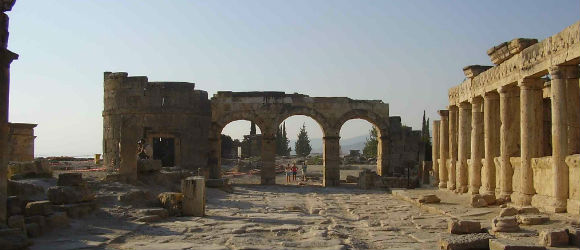The presence of a hot spring at Hierapolis and the spectacular calcium deposits from its water spilling over the nearby hillside suggest that there should be evidence of an early settlement there. The oldest Inscription found so far, however, indicates it was founded by Eumenes II, king of Pergamon, in the latter part of the second century B.C.; it soon became a busy industrial center.
Pagan worship in the city centered around Cybele, Apollo, Artemis, Men, Poseidon, and Pluto. Underneath the Temple of Apollo has been found the Plutonium, an opening in the earth from which a noxious gas still comes. The temple is between the pool where the hot spring rises and the large theater on the side of the hill. To the north along the rim of the plateau is a long avenue of tombs.
Traditionally St. Philip is connected with the early church in Hierapolis. Fairly recently Italian archeologlsts have discovered his Martyrium, an octagonal chamber forming a double cross surrounded by a square. This is almost due north of the theater, also on the side of the hill. It was a fifth century A.D. building and did not last much more than 100 years. No tomb was found with it although that was expected. There are several ruins of churches, one not far from the baths, one on the main road leading to the necropolis.
Hierapolis is listed in the New Testament along with Laodicea as the center of Epaphras’s work (Colos-sians 4:13). This was at the time Paul was writing to strengthen the message Epaphras was preaching and to condemn the “people who go in for self-mortification and angel-worship” (Colossians 2:18). Another less well-known resident of Hierapolis was Papias, a disciple of St. John and the author of the lost book called the Sayings of Jesus.
While Epaphras was is that area, a young slave was growing up in Hierapolis, a boy whose original name is unknown but whom we call by the Greek for “Acquired”, Epictetus. In his Discourses Epictetus often talks about the perfect missionary whose bed was the ground, whose only house the earth and sky and a shabby cloak, and who must love those who misuse him in the service of God. One wonders what the influence of those early Christians, many of whom were slaves themselves, was on this Stoic philosopher.
Hierapolis,


We set off from our very cheap hotel at 5am and were 1st at the ticket office which is open 24hours..and we spent an hour climbing up, taking photos of the pools and the sunrise across the plain below. Then we clambered all over Hierapolis, right out to the necropolis and up to walls beyond the amphitheater. It was a…
Pamukkale must be seen. The pictures cannot do it justice. The walk around it is quite enjoyable and really quite interesting to see it from different angles. I didn't pay for the special swimming pool option, just the public pools. The water in the pools is at most knee level, but I enjoyed a very nice walk down through the…
Hierapolis is an ancient Greek city but its ruins still make you love it especially when you see the greek words on the monuments… I was really touched !
The geological phenomenon of Pamukkale surprises you and the view is breathtaking!
Overburdened with tourists, and really not as nice as other ruins.
A very neat, clean and well kept area. The mountain is pure white and the water a crystal clear sky blue… the terraced traventines seem to be carved out of the mountains. The Heraipolis ruins are well preserved and the amphitheatre on the hill is well worth the visit. The view from the theater is lovely as you are at…
A little hard to get to, but worth it. The mountain is dramatic at night
We took a day trip from Selcuk to see Hierapolis and Pamukkale, and I'm not convinced the 5 hours in a vehicle were worth it. The pools were beautiful and made for some great pictures, but we were only out of the bus for just over an hour.
Plus, the brochures show pictures of people luxuriating in the pools, but…
The ruins of the theater, temples, baths, and other Greek monuments at the site. Hierapolisis located behind of Pamukkale. Long before you arrice in Heirapolis you can see teh gleaming white travertine terrace of Paumkkale. In ancient time religious buildings were built nearby hot or cold water for curing. It is rather small-sized site.
We did a day tour with Crossroads Travel and highly recommend. It is a well designed tour with plenty of free time to explore the area. Three hour drive from Selcuk but well worth it.
The Hieropolis very interesting and the guide very knowledgeable. The travertine and thermal pools are a must see in Turkey. You can walk on the…
In late April 2007 we drove from Gocek to Pamukkale. We went the "scenic" route via Fethiye, Uzumulu and Cameli – mountainous and beautiful scenery, most amaziing geology, nobody – not even a goat! – on the road (except for a bus which somewhat worringly suddenly appeared and seemed to take a different route to us at a diversion for…